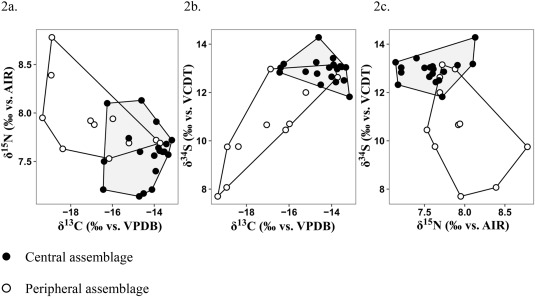A new paper in Deep Sea Research Part I: Oceanographic Research Papers: Multiple nutritional strategies of hydrothermal vent shrimp (Rimicaris hybisae) assemblages at the Mid-Cayman Rise.
• R. hybisae were sampled central to and peripheral of active venting.
• Gut contents differed between central and peripheral assemblages.
• Isotopic compositions differed between assemblages and reflect nourishment source.
• Central assemblages of R. hybisae rely solely on episymbionts.
• Peripheral assemblages have episymbionts and are partially carnivorous.
Alvinocaridid shrimp occurring in dense assemblages close to vigorously venting orifices are characteristic of many vent fields on the Mid-Atlantic Ridge, Central Indian Ridge, and Mid-Cayman Rise. Episymbiotic bacteria of these shrimp are exposed to vent fluids enriched in inorganic nutrients (carbon dioxide, sulfide) that, together with dissolved oxygen in the surrounding seawater, sustain autotrophic growth and supply nourishment to the shrimp. Enigmatically, conspecific shrimp may also be found sparsely distributed in the periphery of a vent field, where there is little visual evidence of vent fluid flux. We tested the null hypothesis that nourishment sources were identical for the central (dense) and peripheral shrimp assemblages, using gut content and stable isotope analyses. Rimicaris hybisae were sampled from central and peripheral assemblages at the Von Damm Vent Field (Mid-Cayman Rise). Guts of centrally aggregated shrimp contained a white material inferred to be bacteria, while peripheral individuals contained this white material and/or pieces of crustacean exoskeletons. C, N, and S isotopic compositions of shrimp muscle tissues were significantly different between central and peripheral shrimp assemblages, and little overlap in isotopic space was found. A comparison of δ13C and δ34S values of gut contents and abdominal tissues revealed that abdominal tissue composition reflects the shrimp’s source of nourishment. Slight but significantly elevated δ15N values in peripheral shrimp, together with crustacean exoskeleton fragments in the gut, suggest facultative carnivory in peripherally aggregated shrimp. The lower δ13C and δ34S values in individuals from the peripheral assemblages are also consistent with a mixotrophic diet. We conclude that central and peripheral assemblages of R. hybisae have different nourishment sources, with central assemblages relying on episymbionts, while peripheral assemblages have diverse nourishment sources comprising bacteria and Crustacea.

